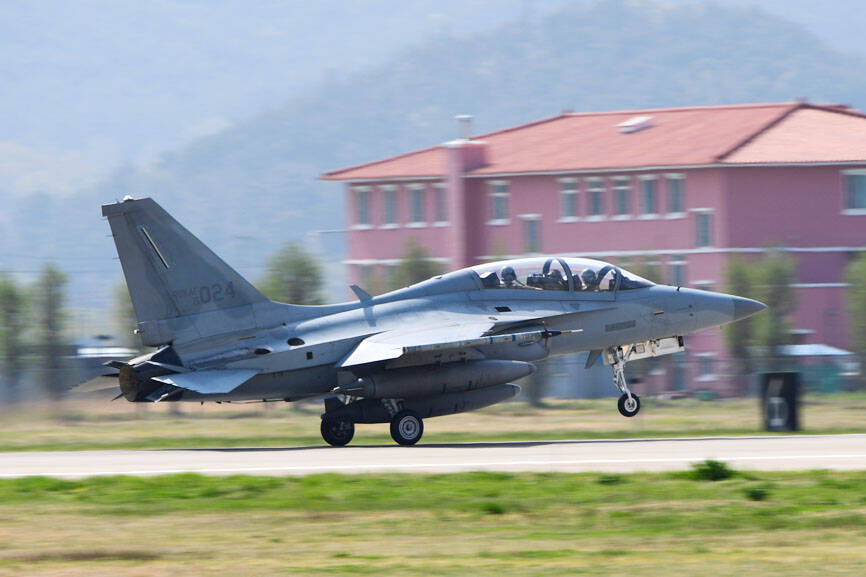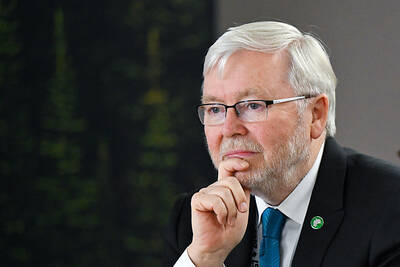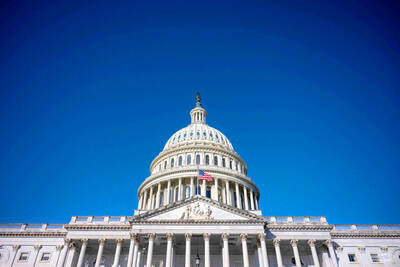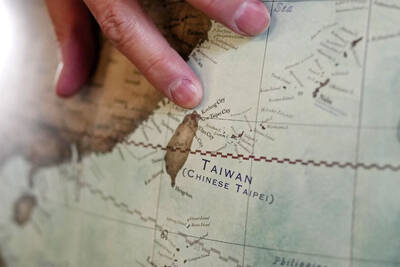North Korea criticized the US for deploying a B-1B strategic bomber in a recent joint military drill with South Korea, describing the move as an “open threat” to Pyongyang’s security, the North’s Korean Central News Agency (KCNA) reported yesterday.
The North Korean Ministry of Defense spokesperson said in a statement carried by KCNA that the deployment of US strategic bombers in the region had become a routine military practice, while calling it “reckless bluffing.”
The B-1B was deployed in a joint military drill between South Korea and the US on Tuesday along with fighter jets, the South Korean Ministry of Defense said.

Photo: EPA-EFE
Jeon Ha-kyu, spokesman for the South’s defense ministry, rejected North Korea’s criticism and said in a briefing that the military activities were defensive in nature.
B-1B bombers have been featured in joint military exercises in the past few years that North Korea has denounced as a rehearsal for war against it, while Seoul has portrayed the exercises as purely defensive.
“The recent military move of the US and the ROK is an open threat to the security of our state and a grave provocation that raises the military tension in the region to an extreme dangerous level,” the KCNA statement said, referring to South Korea’s official name, the Republic of Korea.
The statement said that North Korea “will deter by dint of powerful force the US aggressive attempt to permanently fix the malignant instability element in the security environment of the region.”
The air forces of South Korea and the US yesterday started a two-week joint exercise known as “Freedom Flag,” the South’s defense ministry said, with fifth-generation stealth fighter jets deployed to take on the role of a mock enemy in training.
Additional reporting by AP

NEXT GENERATION: The four plants in the Central Taiwan Science Park, designated Fab 25, would consist of four 1.4-nanometer wafer manufacturing plants, TSMC said Taiwan Semiconductor Manufacturing Co (TSMC, 台積電) plans to begin construction of four new plants later this year, with the aim to officially launch production of 2-nanometer semiconductor wafers by late 2028, Central Taiwan Science Park Bureau director-general Hsu Maw-shin (許茂新) said. Hsu made the announcement at an event on Friday evening celebrating the Central Taiwan Science Park’s 22nd anniversary. The second phase of the park’s expansion would commence with the initial construction of water detention ponds and other structures aimed at soil and water conservation, Hsu said. TSMC has officially leased the land, with the Central Taiwan Science Park having handed over the

AUKUS: The Australian Ambassador to the US said his country is working with the Pentagon and he is confident that submarine issues will be resolved Australian Ambassador to the US Kevin Rudd on Friday said that if Taiwan were to fall to China’s occupation, it would unleash China’s military capacities and capabilities more broadly. He also said his country is working with the Pentagon on the US Department of Defense’s review of the AUKUS submarine project and is confident that all issues raised will be resolved. Rudd, who served as Australian prime minister from 2007 to 2010 and for three months in 2013, made the remarks at the Aspen Security Forum in Colorado and stressed the longstanding US-Australia alliance and his close relationship with the US Undersecretary

‘WORLD WAR III’: Republican Representative Marjorie Taylor Greene said the aid would inflame tensions, but her amendment was rejected 421 votes against six The US House of Representatives on Friday passed the Department of Defense Appropriations Act for fiscal 2026, which includes US$500 million for Taiwan. The bill, which totals US$831.5 billion in discretionary spending, passed in a 221-209 vote. According to the bill, the funds for Taiwan would be administered by the US Defense Security Cooperation Agency and would remain available through Sept. 30, 2027, for the Taiwan Security Cooperation Initiative. The legislation authorizes the US Secretary of Defense, with the agreement of the US Secretary of State, to use the funds to assist Taiwan in procuring defense articles and services, and military training. Republican Representative

TAIWAN IS TAIWAN: US Representative Tom Tiffany said the amendment was not controversial, as ‘Taiwan is not — nor has it ever been — part of Communist China’ The US House of Representatives on Friday passed an amendment banning the US Department of Defense from creating, buying or displaying any map that shows Taiwan as part of the People’s Republic of China (PRC). The “Honest Maps” amendment was approved in a voice vote on Friday as part of the Department of Defense Appropriations Act for the 2026 fiscal year. The amendment prohibits using any funds from the act to create, buy or display maps that show Taiwan, Kinmen, Matsu, Penghu, Wuciou (烏坵), Green Island (綠島) or Orchid Island (Lanyu, 蘭嶼) as part of the PRC. The act includes US$831.5 billion in